NEW: Introducing PlateIQ Premium Reports
This article has been updated to include details on the NEW PlateIQ Premium Reports and integrated LineupHQ Matchup Factors.
No matter if you are new to MLB DFS or a grizzled veteran, the volume of data and analytics in baseball can be daunting.
How do you decide which numbers to put stock in on a day to day basis? How do you stay consistent with the numbers you decide to value? This can be a big challenge for players of all skill levels. Evaluating the matchups via MLB analytics can be a time-consuming problem that not everyone is willing or able to solve.
PlateIQ Premium ratings and Premium reports are here to help with this challenge.
Premium Matchup Reports

At the top of the PlateIQ page, we’ve updated the tool to include two distinct sections:
— PlateIQ Dashboard: This is the core PlateIQ view you’ve come to know and love. All users can continue to view relevant baseball statistics, while premium members can do so with stunning ease using PlateIQ conditional formats.
— PlateIQ Premium Reports: Brand new in June 2018, PlateIQ Premium Reports is a set of never before seen DFS specific scouting reports you can use to dive deep on all of today’s batter vs. pitcher matchups. You’ve had access to the PlateIQ score, and now you can lift up the hood and see the factors driving today’s number.
There are currently six Premium Reports that will be available in 2018:
— Matchup Factors
— Recent Trends
— Contact
— Production
— Plate Discipline
— Context

At all times during your experience in PlateIQ Premium Reports, you’ll be able to view the overall category ratings for both batter and pitcher side by side.
Matchup Factors Report and LineupHQ Integration
Now Available in LineupHQ, you will find two columns to the right of PlateIQ Score: Positive Matchup Factors and Negative Matchup Factors. Premium members can now see a count of the highly positive and highly negative factors impacting today’s matchup rating. By hovering over the column, LineupHQ will now display these factors in a very helpful and time-saving fashion.

These factors can also be viewed in the PlateIQ Premium Reports Section in an easy to read report as shown below.
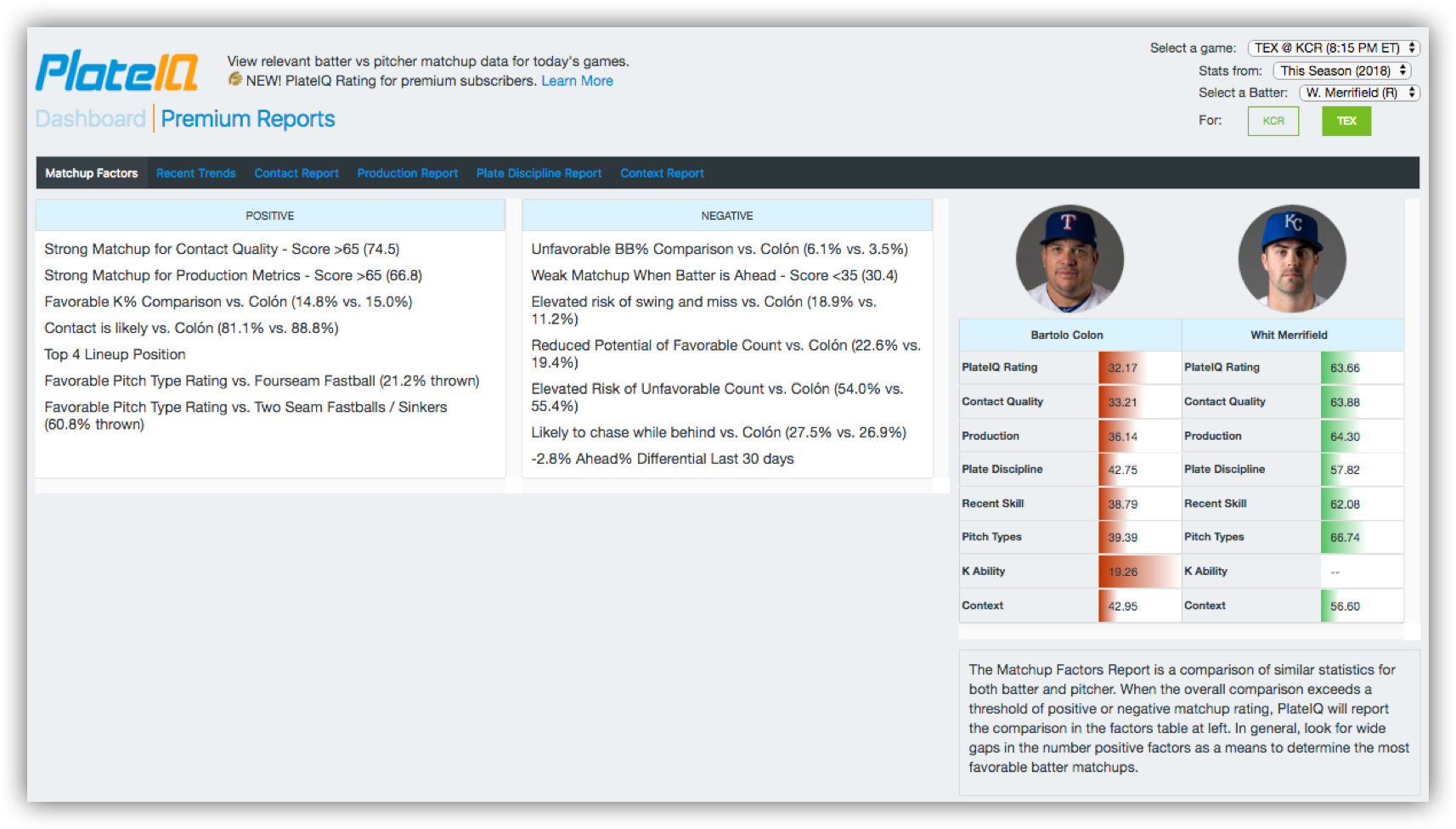
The factors are driven by a comparison of relevant stats for today’s games. When both a batter and pitcher display traits that result in a highly positive or highly negative rating, PlateIQ will trigger a matchup factor that advises you of the widely varying performance metrics. The goal is to help you save time researching MLB DFS.
Recent Trends Report
The Recent Trends Report is here to help you better understand the recent performance of every player on today’s slate, and compare it to their past 12 months. The goal is to identify noteworthy differentials for further evaluation.
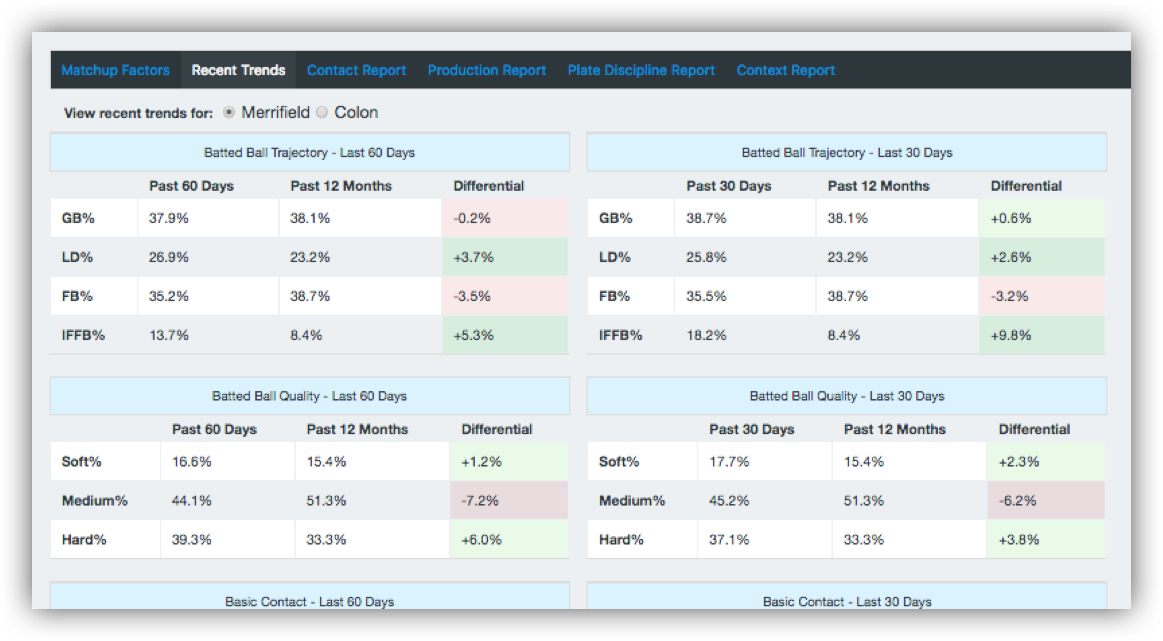
One of the key features in the recent trends report is the pitch type recent trends table. This table will quickly help you visualize changes in pitcher velocity and pitch type usage in the past 30 days as compared to the past 12 months.
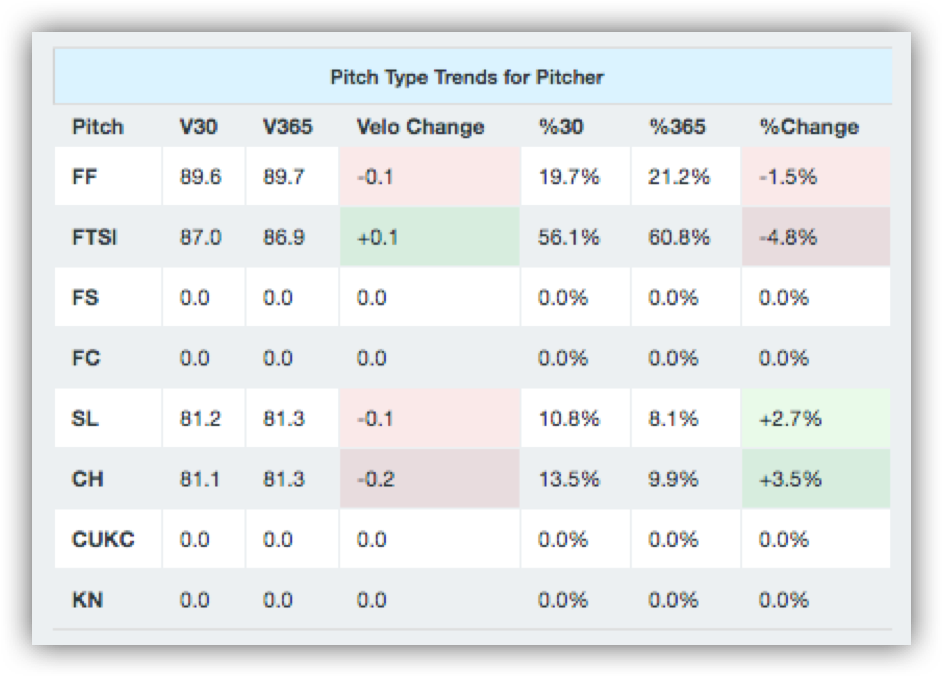
Context Report
The context report shows information that is not directly related to the batter vs. pitcher matchup that occurs at the plate. This includes weather, park, stolen bases, vegas, umpires, and expert consensus.
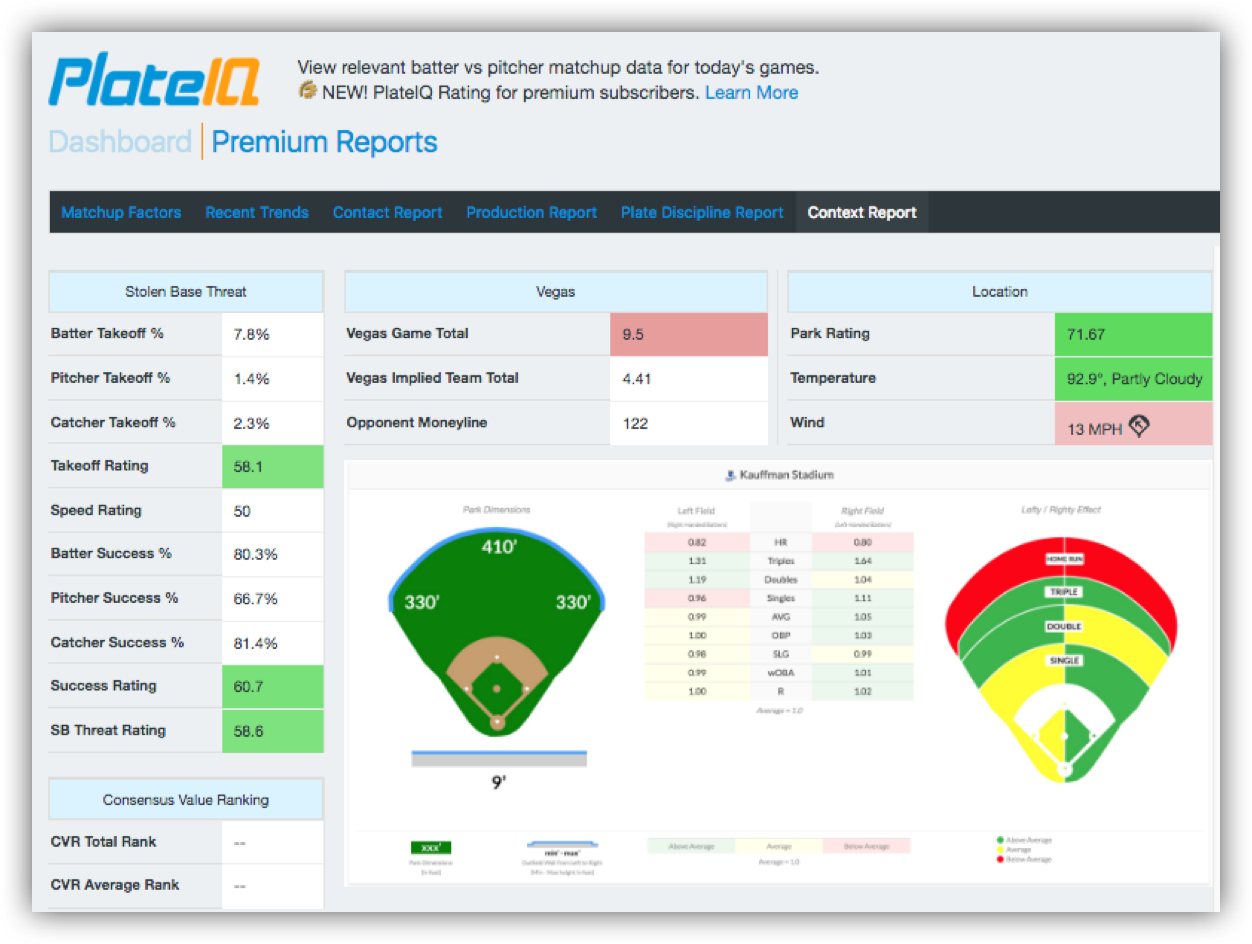
Production Report, Contact Report, and Plate Discipline Report
PlateIQ premium reports now provide a window into some of the stats used to calculate PlateIQ scoring. This can be accomplished by examining the Production Report, Contact Report, and Plate Discipline Reports.
Production Report: Details basic productivity related stats and how batter and pitcher compares. It also features a detailed zone report in a tabular view. Displays the PlateIQ ratings for both overall and vs. split numbers.
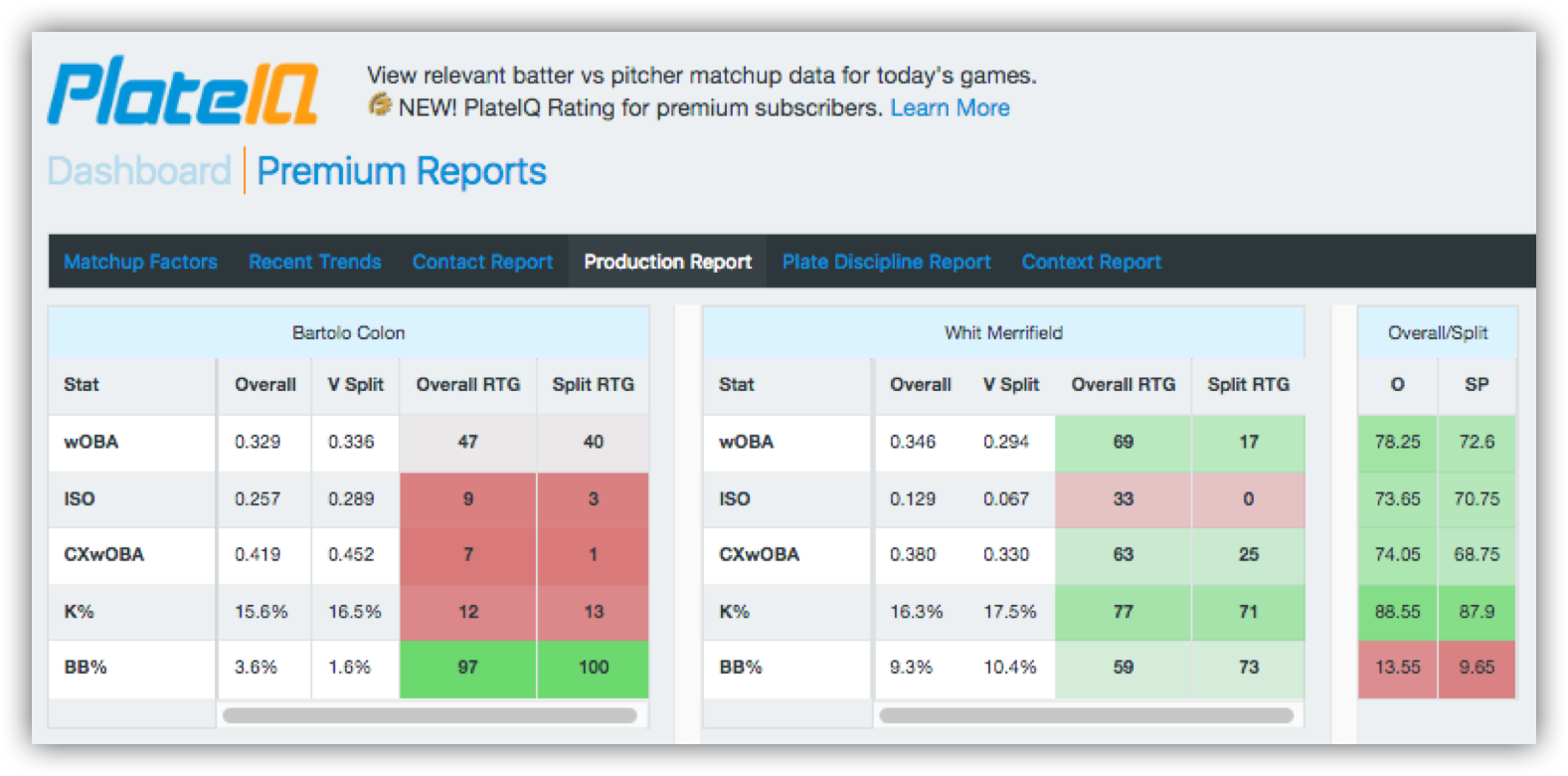
Contact Report: Details on contact trajectory and contact quality statistics for both batter and pitcher. Displays the PlateIQ ratings for both overall and vs. split numbers.
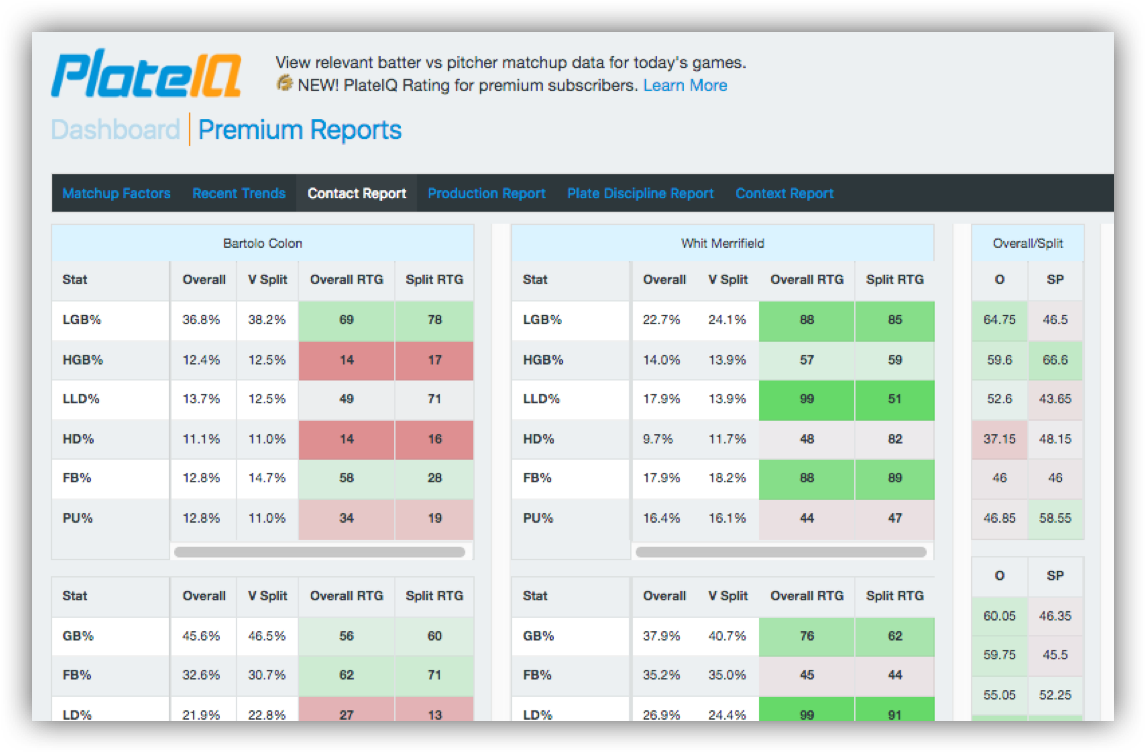
Plate Discipline Report: Details on plate discipline statistics for both batter and pitcher. Displays the PlateIQ ratings for both overall and vs. split numbers.

How To Best Use These Reports
The PlateIQ Premium Reports are designed to be used in conjunction with the PlateIQ Score. When you spot a rating that you’d like to know more about, you can drill down as far as you’d like to understand what drives the number. Matchup Factors provide you a remarkably time-saving way to get information directly in the LineupHQ tool. The integration provides a direct link to PlateIQ without changing your view. When working in PlateIQ, the complete set of premium reports are there for you to dig deeper if your curiosity demands it.

We hope you enjoy the experience of PlateIQ Premium Reports, and can now save time researching MLB DFS. Best of luck as you build better lineups!
Plate IQ Ratings
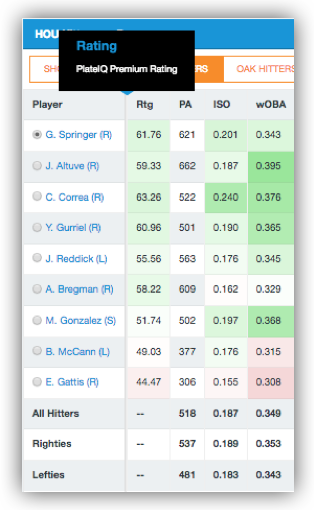
WHAT IS IT? PlateIQ Rating is a dynamic matchup score. PlateIQ Rating compares over 1,000 important statistics and data points for today’s games and condenses the situation into a single number. PlateIQ Rating updates as lineups release to ensure new information is considered leading up to lock.
WHAT IS IT FOR? PlateIQ score is your companion for narrowing a player pool, and reducing research time.
WHAT IS IT NOT FOR? PlateIQ score is not a projection. It is not intended to be a replacement for projection models. We certainly see a correlation, and may in the future optimize the system for use in the LineupHQ builder. For now – the matchup score is best used as an intelligent guide to narrowing your player pool.
WHERE CAN I FIND IT? PlateIQ Premium Ratings are located in both PlateIQ and LineupHQ for premium members.
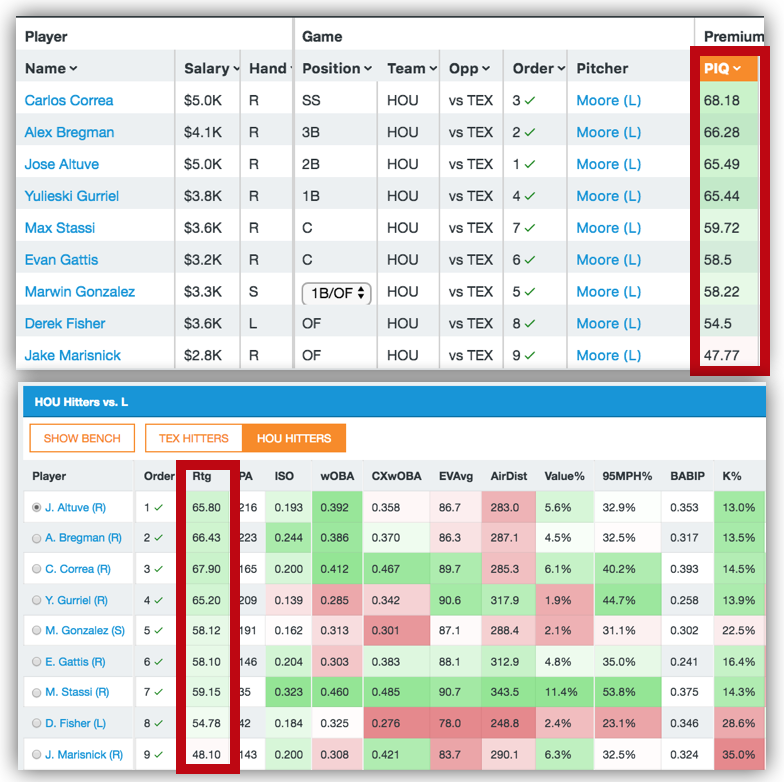
WHAT ELSE IS COMING? PlateIQ Score is Phase I of the PlateIQ Premium Tools platform. Phase II is a new dashboard featuring “Premium Batter Reports” as well as a category by category summary of what is happening under the hood.
The idea is that you’ll have the option to play MLB DFS armed with the power of data no matter your skill level. If you are somebody who isn’t interested in the numbers, you can leverage the premium rating as a strong representation of the data. If you want to dig deeper and understand “why”, you’ll be able to do that with the Phase II elements. Look for Phase II to be released in the coming weeks. For now, the PlateIQ Dashboard is here to help break down the numbers for those that desire. We’ll update this article with new information when Phase II is ready.
How to Read the Output
Overall Score: The PlateIQ premium scoring is designed so that a matchup rating if 50 should be close to an average matchup. The farther away from 50 a score is on the high side, the better you should consider the overall matchup for a player. The lower the score is below 50, the more negative you should perceive the matchup for a player. Generally, scores tend to reside between 25 and 75.
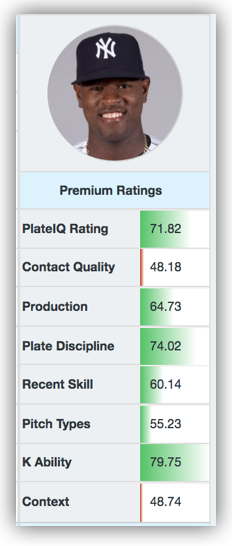
Subscores: There are six total PlateIQ categories that get evaluated on a daily basis and a 7th category just for pitchers to better account for DFS viability. Here are the categories that are a part of PlateIQ Premium Matchup Ratings.
— Contact Quality
— Production
— Plate Discipline
— Contextual Factors
— Recent Performance
— Pitch Types
— K Matchup
We’ve added conditional formats to the ratings to help you understand them. Higher numbers are superior for the player in question.
What is Being Evaluated?
PlateIQ reviews, compares, and rates over 1,000 different data points. Sounds fancy – but it’s mostly splits and different time frames of some really basic and common evaluators.
- Contact Quality: Batted ball trajectory stats. Batted ball quality stats. Examples: GB%, Hard%, Speed-Angle combination stats.
- Production: Statistics that describe the outcomes displayed by a player. Examples: wOBA, BB%, Indicators.
- Plate Discipline: Skills displayed by batters and pitchers controlling the PA. Examples: Contact%, SwStrk%, OSwing%, Batter Ahead%
- Contextual Factors: Elements outside the realm of evaluation in a single pitch. Examples: Batting Order, Weather, Park, Umpire
- Recent Performance: A Review and rating of more recent behavior across categories. Example: EV Differential, Pitcher Velocity Change, 60 Day K%
- Pitch Types: An evaluation across categories to measure and rate performance on or vs. a pitch type. Example: GB% vs. FT. Whiff% vs. SL. Contact % vs. CUKC.
- K Matchup: An increase in weight to the K% matchup for starting pitchers only. This is designed to help account for the value of strikeouts in DFS.
How Should You Use It?
Shorten your research process by identifying key matchups: Use PlateIQ and (coming soon) PlateIQ Premium Matchup reports to further drill down to the “why” once you identify “who” to spend your invaluable time evaluating.
Narrow your player pool using the integrated PlateIQ score in LineupHQ: Easily visualize strong matchups and make decisions on player pool using your own skill and judgment.
Understand new situations quickly: PlateIQ Premium Score updates as new lineups release. You’ll be able to quickly visualize the matchup with the help of PlateIQ score, and reduce the stress that may be caused by a late-breaking lineup change.
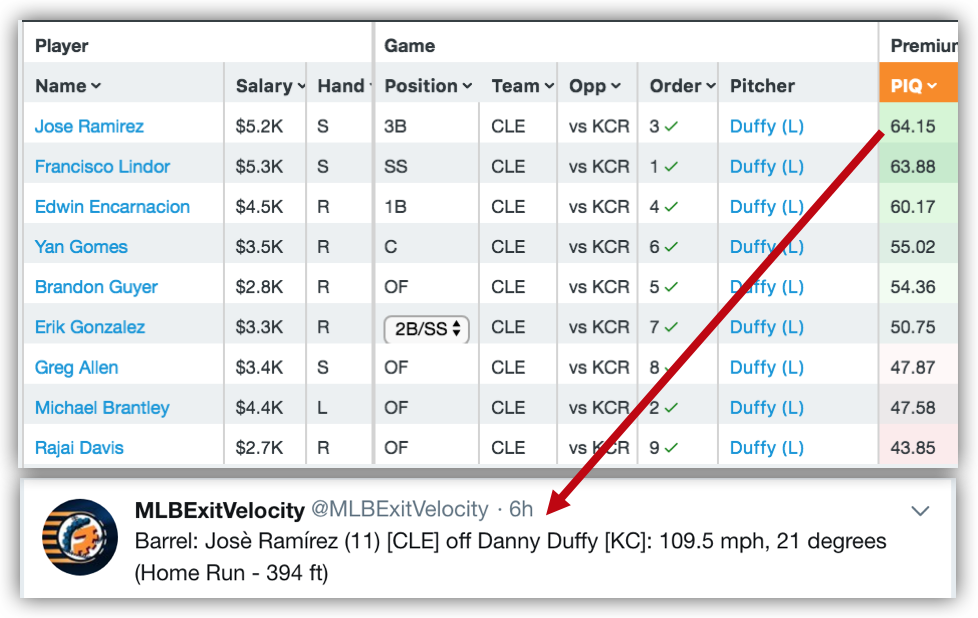
Tips, Tricks, and Limitations
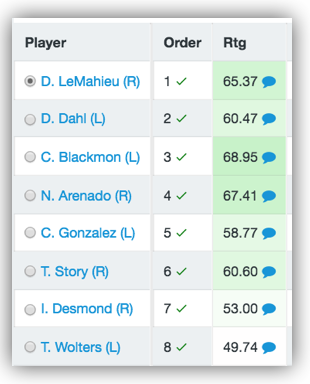
— Generally speaking, a higher score is better. However, a higher score will not always mean a better play in DFS. You’ll still need to exercise your own skill and good judgment in understanding and evaluating the PlateIQ Premium Rating.
— We noticed a few situations that we want to find new and better ways to adjust for automatically. Particularly how we handle new players, players with rapidly changing skill profiles (usually pitchers), and some other uncommon scenarios. We’ll from time to time make note of an adjustment in PlateIQ (as shown at right via comment balloon).
— This solution will update automatically as lineups release and contextual factors adjust. We’re excited by this and hope you’ll find value in watching the score adjust as the situation changes.